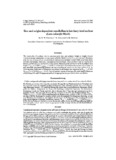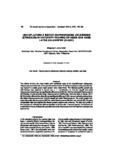Sea bass hatchery operations
- Global styles
- MLA
- Vancouver
- Elsevier - Harvard
- APA
- Help
Share
抄録
The manual addresses sea bass (Lates calcarifer) fry production in the hatchery. It describes the principles and practical procedures for rearing sea bass - from eggs until metamorphosis - as practiced by the SEAFDEC Aquaculture Department in Tigbauan, Iloilo, Philippines. It is presented under the following main section headings: General principles; biology; Selecting a suitable site; Design - tank systems, seawater supply system, freshwater supply system, aeration system, other facilities; Broodstock - source of breeders, breeding techniques; Egg collection, transport and hatching; Larval rearing - stocking density, feed types and feeding management, water management size-grading of larvae; Harvest and transport of fry; and, Propagation of larval food - Chorella, Brachionus, Artemia, Moina.
Subjects
Hatchery fishes記述
A 42-page manual updating AQD's 1990 publication of the same title. It details the activities in the seabass hatchery, from breeding until the harvest and transport of fry to fishponds. New section on the propagation of natural food Moina and Diaphanosoma has been added.
Suggested Citation
Parazo, M. M., Garcia, L. M. B., Ayson, F. G., Fermin, A. C., Almendras, J. M. E., Reyes Jr., D. M., Avila, E. M. & Toledo, J. D. (1998). Sea bass hatchery operations (2nd ed.). Tigbauan, Iloilo, Philppines: Aquaculture Department, Southeast Asian Fisheries Development Center.
Type
BookISSN
0115-5369ISBN
9718511296シリーズ
Aquaculture extension manual; No. 18Format
42 p. : figs.
Collections
Related items
Showing items related by title, author, creator and subject.
-
Size- and weight-dependent cannibalism in hatchery-bred sea bass (Lates calcarifer Bloch)
Parazo, M. M.; Avila, Enrique M.; Reyes, Deogracias M., Jr. (Blackwell Publishing, 1991)The relationship of predator size to maximum prey size, and predator weight to weight of prey consumed among cannibalistic sea bass (Lates calcarifer Bloch) in a hatchery were assessed. Maximum prey size was computed from ... -
Use of juvenile instar Diaphanosoma celebensis (Stingelin) in hatchery rearing of Asian sea bass Lates calcarifer (Bloch)
de la Peña, Milagros R. (Society of Israeli Aquaculture and Marine Biotechnology, 2001)The effects of size, dry mass intake and nutritional value of the brackishwater cladoceran, Diaphanosoma celebensis, on the growth and survival of 15-30 day sea bass (Lates calcarifer) larvae reared in a static green water ... -
Hatchery rearing of sea bass Lates calcarifer Bloch
Parazo, M. M.; Reyes, Deogracias M., Jr.; Avila, E. M. (Science and Technology Information Institute, 1991)A hatchery rearing scheme for sea bass (Lates calcarifer Bloch) is described. Survival rate from hatching (d0) to harvest (d30) was 34%. Feeding sea bass fry with Chlorella-fed or Selco-enriched instar II Artemia from d19 ...








